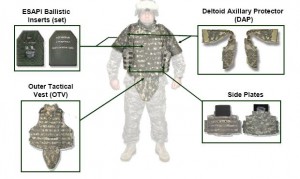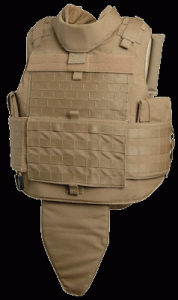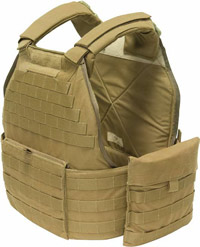Army Delays in Body Armor Testing
BY Herschel SmithFrom Stars and Stripes:
The Army’s policy of testing body armor at its own laboratory instead of private facilities is causing delays in approval and is raising costs for manufacturers, The New York Times reported.
Army officials told the paper on Tuesday the decision to test armor at Aberdeen Proving Ground in Maryland was made as part of an effort to upgrade safety standards. However, they said they might still hand some of the work back to private labs if delays became common.
According to the Times, manufacturers said the cost of the tests has in some cases tripled, and results that might be returned within 24 hours from a private lab are taking as long as a week to be returned from the Army lab.
Asia Fernandez, who owns Armacel Armor in Camarillo, Calif., told the Times that the Army charged more than $50,000 to perform safety tests on a new product. Testing at a private lab, she said, would have cost less than $15,000.
“It’s a little rocky right now,” said David P. Reed, the president for North American operations at Ceradyne, the Army’s largest body-armor contractor. The Army lab, at the Aberdeen Proving Ground in Maryland, “is not really as responsive as we’d like to see,” he told the paper. Reed added that so far the delays have not hurt troops because the Army had been stockpiling armor.
However, congressional aides told the paper they were looking into the accusations to ensure that there are no delays in getting critical gear to servicemembers in the field.
It is, after all, the Army. To expect that the Army would keep people in their employ who were technical experts in all areas of application is unreasonable. Also, this report doesn’t say that the Army did not perform adequate testing. But the efficiency with which it is done calls into question the propriety of having this function done in-house. The Captain’s Journal has addressed this before.
Given the lack of confidence inspired by the federal government, independent consultative support is necessary to restore the public confidence in the system. Support, that is, who doesn’t stand gain from whatever conclusions that are reached. This is necessary for not only proof of principle for future body armor designs, but for currently deployed armor we well.
While not exactly addressing the same issue, we have recommended independent consultative support for body armor technology. This wouldn’t preclude corporate-based testing by the manufacturer, but it would necessitate an independent assessment and some kind of oversight; not oversight that the Army could deliver alone, but as assisted by engineers and technical experts.
In further news, proposed legislation may force the issue.
Representative Niki Tsongas has introduced legislation that would require the Pentagon to develop lighter body armor for soldiers in an effort to reduce the thousands of orthopedic injuries reported each year as a result of lugging heavy gear.
The Lowell Democrat, a member of the Armed Services Committee, introduced the bill Tuesday and has enlisted the support of other key lawmakers, including Representative Neil Abercrombie, the Hawaii Democrat who chairs the panel’s Air and Land Forces Subcommittee, her office said today.
The legislation would set up a special task force to evaluate various personal protection technologies that could provide the same level of defense as current body armor, but with reduced weight, according to the bill.
Tsongas told the Globe that in the course of her investigation of the issue, including in committee hearings and discussions with an Army captain who serves on her staff, she found that the amount of gear that troops must carry is sometimes too much to bear.
“There is a tendency to take it off,” she said in a brief phone interview.
And many soldiers exhibit lasting health effects from wearing their personal gear for long periods of time.
In 2007, the Army reported 257,000 injuries attributed to the stress of bearing heavy loads during repeated deployments. The service’s vice chief of staff, Gen. Peter Chiarelli, estimates that such injuries are currently sidelining 20,000 soldiers.
“With the increased emphasis on Afghanistan in the coming years the load that soldiers must carry will no doubt become more of an issue,” said John Noble, a spokesman for the two-term congresswoman.
Tsongas’ bill would also establish a separate program in each branch of the military dedicated to the research and procurement of body armor. Such efforts are now included in multi-billion dollar research accounts that cover all types of military equipment.
By establishing a stand-alone funding stream Tsongas believes Congress will be able to monitor how much money is being spent on body armor and better identify shortcomings.
“This is so we know exactly what is there and that it is being spent appropriately,” she said.
This also follows closely with our previous recommendations to lighten the load that Soldiers and Marines carry. Our first target has been the weight of the SAPI plates (Side Arms Protective Inserts), the heavy ceramic plates help by the carrier in the front, back and sides. The soft ballistic panels carried throughout the carrier is not a significant actor in the overall system weight.
The Army also happens to be testing lighter armor at the present.
FORT BELVOIR, Va. — The Army will test lighter body armor next week with plans to field up to 100,000 sets beginning in August, said Lt. Col. Robert W. Myles Jr. of Program Executive Office Soldier.
The tests will take place May 11-22 in Yuma, Ariz., and will involve 10 Soldiers from the 173rd Airborne Brigade Combat Team and 25 Soldiers with the 82nd Airborne Division, Myles said Wednesday.
Soldiers can carry a load of about 100 pounds of gear, body armor and ammunition. The Improved Outer Tactical Vests that Soldiers currently wear weighs about 31 pounds with all four ballistic plates, Myles said.
The Army will evaluate four new types of body armor, each weighing about 24 pounds, as well as body armor already worn by Soldiers, Marines and Special Operations Forces, he said.
The body armor will be evaluated based on ballistic tests, form, wear and comfort, and cost, Myles said.
As a stop-gap measure, the Army will soon issue a battalion of Soldiers with the 4th Infantry Division the lightweight body armor that Special Operations Forces wear, he said.
“We want to lighten the load as quick as possible; that’s our No. 1 goal,” Myles said.
In January, Gen. Peter Chiarelli, Army vice chief of staff, told reporters that an increasing number of Soldiers were becoming nondeployable in part due to musculoskeletal injuries from the heavy loads they carry.
“You can’t hump a rucksack at 8,000-11,000 feet for 15 months, even at a young age, and not have that have an impact on your body,” Chiarelli said during a roundtable with reporters.
Exactly right. And lighter armor should have been issued much earlier, including the same type worn by SOF if that is lighter than the IBA and MTV (the IBA with panels and SAPIs is about 31 pounds, the MTV with panels and SAPIs is about 32 pounds with groin and neck protectors).
The article doesn’t make clear what the weight modifications involve, and the recommendations we have made include the same level of ballistic protection with less weight. It’s all a matter of funding and research. The health and maneuverability of our warriors is of paramount importance to any campaign, even more so than non-infantry related gear and equipment. The functionality of infantry gear and equipment may redound not only to the success of the campaign and deployability of the troops, but to their very lives. This makes it worth the investment, whatever that cost is.
Prior:
University of Virginia Student Designs New Body Armor
DoD Testing Requirements for Body Armor and Army Recall
Changes in Body Armor for Marines







